#Modular & Theme system
Explore tagged Tumblr posts
Text
Babylon's 6 D&D Tips
I DM’d D&D for ten years. I started in middle school, and I kept it up until my sophomore year of college. This is my mini-guide for what the game is, what it isn’t, and how to play it well. So. From the top.
Tip 1: Don't make your main storyline time dependent.
D&D is an amazing open-world experience. You can pick at any detail. Nothing is a non-interactable part of the scenery. If there’s a sewer manhole, you can lift it up and climb down. If there’s a house, you can look inside and rob it. If there’s an NPC that you meet at the market, you can follow them home and see their whole life. Their parents, or their partner, their trade - all of it. It will be made up on the fly by some sort of reasonably skilled improv speaker, but it will also exist after that. That’s how the world is built. That’s the secret sauce that makes D&D beautiful.
If your plotline is too urgent, it kills those opportunities. The worst example of this that I have isn’t even from D&D, but FO4. The game is clearly built around exploration and adventure. The plot is built around rescuing your kidnapped baby. There’s a lot of tension between those goals. The plot does not work with the game mechanics, and it's really, really, jarring.
Be wary of doing that. It's surprisingly easy.
Tip 2: Don't set up giant, epic, fantasy battles between multiple armies.
D&D is not a very good epic-battle simulator. There are games that have streamlined combat mechanics to allow for whole armies to fight, but D&D is very detail oriented, and trying to control too many people at once makes combat slow to a crawl. That very creative DM who can tell you every detail of an NPC’s life is also just not very good at multitasking.
If you really, really want to - fine. But you should be ignoring standard mechanics when you do so. Move to a “cinematic mode” and just go by vibes. And generally, take a moment to “get” the game before modifying it. If the kind of plot you really want is urgent, and involves epic scale armies, maybe look into different RPG systems. D&D specializes in exploration and small, focused parties. Using it for things outside of that is kind of like hitting nails with a wrench.
Tip 3: Don't prepare your plot like it's a book. Kill your lore codex.
D&D is a collaborative storytelling adventure. That's the secret sauce. Writing out codexes and trying to crystallize the world before you start playing ruins the collaborative element. It’s genuinely better if you build as you go. It lets your players give input. And it saves you a lot of time. Why bother trying to write up who the Mayor of Snoresville is if there’s a good chance your party never even talks to him?
(I would also apply this to writing in general. If you want to write all of your world's lore before starting your book, you'll never start your book. And you'll go crazy. Fear the lore codex.)
Tip 4: Prepare your combats and your NPCS rigorously, but generically.
This ties in to Tip 3. If you spend a lot of time preparing the lore of the Bandit Leader of Redgrove, things like his family history, or his trauma, or his deep-down character motivations, and then the party never goes to Redgrove, it all goes to waste. D&D evolves rapidly and chaotically, so building things in a modular, reusable way really pays off.
So. I tend to have two big pools for my NPC work. One is a character sheet pool. I keep it small and focused. I can generalize most melee classes ahead of time, so I can have an Archer, a Brawler, a Tank, and some Generalist Infantry. That’s like, 80% of your martial enemies, done. Spellcasters are a bigger pain in the ass, but a few pre-mades thrown into a campaign pays off if you know your themes. If you’re dealing with a death cult, make some death clerics. A dragon will probably have sorcerer acolytes.
My second pool is a pool of character mannerisms. Some should absolutely be practiced ahead of time. Figure out what mannerisms make your villain really pop. And if the party skips that villain, just move those mannerisms to some new guy down the line and you’ll still be fine. Nothing wasted. A lot of the mannerisms are going to be picked with no heads up when the party does something weird, like following a random merchant around for a few days just to see how they live. You can get through almost all of those extremely well with just variations on the 4 humors, the 3 socioeconomic classes, and regional dialects.
Tip 5: Give your players permission to inject themselves into the world.
It is common for people to over-formalize the rules and responsibilities of “being a player” vs. “being a DM.” I think the most common way to phrase it is something like “The Players are in charge of their characters and their backstories, the DM is responsible for the worlds and its NPCs, and both need to stay in their lanes.”
It’s isn't just better to mix it, it's necessary.
Failing to share these roles forces the world to exist in a crystallized state before the campaign even starts - at least if you want to integrate backstories into the plot. Groups that fail to do this can often feel like the characters were born the day the campaign began, and did nothing interesting beforehand.
So, for DMs: Don’t be afraid of trying to inject NPCs and details of this world into your player's past. Imagine that your party rogue goes into a town and finds a fence for selling some stolen trinkets. Maybe, have the fence recognize the rogue. “Gods of fire, it’s McClellan. I haven’t thought about you since the candy-rat incident. You took a real beating making sure I got away that day. Glad to finally have a chance to pay you back!”
Now, the rogue still has a choice here. They can say something like “Ah, this guy is mistaking me for someone else, but I can roll with it to get a better deal.” It’s their character, and their choice. But they can also go, hey, I do know this guy. I was apparently part of something called “The candy-rat incident.” I can decide how I know this guy, and where, and for how long, and what that incident was. That’s not less control - that’s more!
And for players: Don’t be afraid of injecting your past into the world. Maybe you’re a fighter in a wartorn setting and you run into a group of deserters robbing refugees by the roadside. The DM has clearly planned this as some vindication, some enemies you get to thrash without feeling bad. But you have different plans. You take your helmet off, and you look the deserter’s leader in the face, and you say “Jack, you saved my life back on Stone Ridge. You were a good man once. You could be one again. Ride with us.”
Now that's powerful stuff. Do you even know what Stone Ridge is? Hell no. Are you gonna? Hell yeah. And what you just did was way better than the DMs plan of bonking bad guys to feel good. You changed the writing of the world, commandeered an NPC, and made the whole encounter far more interesting.
Tip 6: Ignore all portrayals of D&D in the media.
The best players that I get are people with no experience with D&D of any kind. The second best are those that are willing to drop their preconceptions at the door and just play. The worst are people that have seen D&D portrayed somewhere and are insistent on imitating the portrayal. The exact nature of the failure varies - at worst, they’ve seen some kind of tongue-in-cheek parody, like order of the stick, and then hyperfocused on all the worst parodied aspects as the whole point of the game. D&D is not about outsmarting the mechanics (which is trivially easy, and largely pointless - it just makes your own storytelling less fun), nor is about turning everything into shallow tropes about Horny Bards and Dumb Fighters and Insufferable Paladins. At best, they’ll have seen some kind of ultra-cinematic example of D&D played on a podcast, where the DM has a theatre degree and ever party member is a professional actor. Those people are nice, but they often have unrealistic expectations.
#d&d#DM tips#player tips#collaborative storytelling#I mostly played 3.5#and then later pathfinder#I tried 5e but i never did it long enough to get super good at it#the game economy being so vague put a lot of pressure on DMs which i didnt like#but it also removed a constant source of dumb shenanigans#something something these are just my opinions#but it was good at what i did#and im cocky enough to say ignore at your own peril#a player that can't be trusted with some creative control of a minor bandit is a player that shouldnt be in the game#and if you have a good player#hell#let them try out the bbeg
480 notes
·
View notes
Text
Copper Changes Color - A.H



all you wanted was to stop your new kitchen from flooding. what you got was a crash course in home repair, body awareness, and what mr. hotchner looks like in a dripping dress shirt

pairings: aaron hotchner x intern!reader warnings: suggestive themes, mild accidental injury, clothing transparency, mentions of aging (el oh el), slow burn (with water damage), sexual tension but we r making it neighborly, age gap, home repair as foreplay, science girl flirts via plumbing vocabulary, ballcock failure (swear) wc: 1.9k

Water sluices through your shoes in persistent little pulses, seeping into your socks and establishing a semi-permanent colony in the crevices between your toes.
You purse your lips and pitch yourself forward, clutching at the hem of your tank like you might peel the cold from your skin if you just squeeze hard enough. It doesn’t work. Of course it doesn’t.
The fabric clings tighter instead, now suctioned to your spine, a damp, vindictive second skin with a grudge. (Hydrophilic fibers. That’s why. Cotton loves water. An ironic choice, in retrospect, for someone who knows that cellulose absorbs up to 27 times its own weight.)
So now you’re mid-drip, mid-shiver, mid-existential reckoning over the catastrophic intersection between you and the American household plumbing system when the door swings open.
And there he is, framed in clean lines and afternoon light — your neighbor, your new neighbor, your prohibitively attractive, aggressively symmetrical new neighbor.
What a great impression you seem to be making judging by the look he gives you, as if trying to discern whether this is a cry for help or just your natural state of being.
You realize, belatedly, that you don’t even know which one you’d prefer him to believe.
“Hi! I — okay. This is probably the weirdest neighbor interaction you’ve had all month. Maybe all year. But my kitchen kind of exploded? Not exploded-exploded, there weren’t any flames or concussive blasts or flaming shards of sink shrapnel, just… water. A lot of it. From a valve? Under the sink? It’s called a ballcock, which sounds fake but it’s a real word, I checked. Anyway there was, like, geyser-level water pressure shooting into my ceiling and I didn’t know what else to do, so I came here. Not because I thought you could fix it, necessarily, unless you can? But mostly because I panicked. Which I don’t normally do.”
He regards you silently for a moment, his expression closed off, reminding you of a combination lock, one your brain immediately fumbles through every numeric permutation it can conjure to open it.
“I can come take a look. And call a plumber.”
He gestures for you to lead the way, falling in step behind you, or maybe beside you. It’s hard to tell. Spatial awareness takes a backseat the second his eyes dip toward the distressingly see-through state of your shirt.
He jerks his eyes away in gentlemanly fashion, burning himself on a hot stove.
Clearing his throat, he recovers, “Do you know if your water main’s outside or under the sink?”
You cross your arms, an attempted picture of casual confidence, though realistically more akin to frantic self-containment via strategically placed limbs.
You hope he doesn’t notice.
“It’s under the sink, I think. I mean sixty percent of residential shutoff valves are installed there, though some new models route to an external main, especially in cold climates, but this house predates modular plumbing standards so — yeah. Probably the sink.”
He nods once, as if you had offered a completely ordinary and appropriate response. As if normal people regularly volley niche plumbing statistics at each other in casual conversation.
Most people — regular, socially adjusted humans — would’ve blinked. Or winced a little. Or at least made that polite, closed-mouth “ah” sound that universally signals, please, for the love of god, stop talking.
But not Mr. Hotchner. (Aaron? Hotchner? You weren’t sure which name was appropriate.) He just steps into your house, either unfazed by you or polite enough to hide his confusion exceptionally well.
He crosses the kitchen in three measured strides, slacks neatly creased, white dress shirt still buttoned to the collar.
His posture practically screams executive burnout, like he spent his entire day navigating high-stakes conference calls and patiently explaining things to people he silently considered throttling.
You conclude swiftly and confidently that he must be some kind of CEO. Something complicated, lucrative, and mildly sinister. Finance, perhaps. Or no, something with a more predatory reputation. Venture capital? Private equity? Arms dealing? (Okay, not arms dealing.)
Whatever it is, you’re sure it involves quarterly earnings calls, shareholder appeasement, and an extensive collection of expensive ties.
But then again, he does live here. In this neighborhood, which is lovely, sure, all quiet and sun-dappled, all responsibly pruned hedges and tasteful porch lighting. You love it. You also could never have afforded it if the house hadn’t been, you know, inherited.
Still, it’s not exactly executive-suite-level real estate.
Unless, of course, he’s one of those hyper-rational finance-blog devotees who preach aggressive saving strategies and believe visible wealth is for amateurs. You could picture that. Actually, it fits him perfectly. Or at least, it fits perfectly with the version of him your brain is assembling based on fifteen seconds of sidewalk interaction and your wildly unused behavioral science coursework.
You haven’t exactly been studying him, per se, but certain details lodge themselves in your pattern-attuned brain. It can’t be helped.
He leaves early. Returns late, consistently solo, and displays zero evidence of a cohabiting partner. There’s no second vehicle, no conspicuous brunch plans on weekends. His grocery trips result in single-serving bags and he waters that one sad potted plant but never waves at Mindi Daugherty across the street who strategically times her daily walks past his house in distinctly flattering activewear.
He also runs every morning. You know this in the same way you know tides shift or birds migrate because he passes your porch at precisely 6:12 AM.
Same routine, same pace, same gray T-shirt darkened at the collar and clinging to upper-body definition. You’ve taken to waking up early under the noble guise of catching the sunrise before class, gaze angled vaguely toward the horizon, which just so happens to intersect with his jogging path.
But now, with him crouched at your sink, sleeves pushed past his forearms — which, by the way, are absolutely in the top percentile of forearm presentation — you confirm those jogs have a definitive purpose. Strong legs. Powerful quads capable of door-demolishing force. Not that you’ve considered that.
“Can you hand me that towel?”
You comply instantly, arm extending stiffly, acutely aware of the warmth radiating off him in slow, magnetic waves, like a space heater, or maybe a heat lamp, but one inexplicably gifted with superb genetics and bone structure.
He takes it, fingers brushing yours in an accidental collision. You would think it’s negligible by most standards, and yet your entire sensory network lights up simultaneously.
Without a word, he resumes his investigation beneath the sink, using the towel as makeshift padding for one knee.
You shift your weight, then decide proximity is crucial for educational purposes, lowering yourself onto the tile, whose damp chill promptly seeps through your leggings. Not enough to dissuade you.
“What exactly are you looking for?” you ask, voice soft so it doesn’t bounce too loud in the small kitchen.
“Fault point on the fill line. If it’s clean, it’s a seal issue. If it’s corroded, you’ll need a full replacement.”
Your lips turn to a frown.
“If it is corroded, is it something you can patch temporarily or is it full replacement only?”
He turns to respond, but his gaze slips past your eyes, dropping downward for what seems like the seventh time in ten minutes, and precisely then, his arm brushes the loosened valve with just enough force to dislodge it.
Water explodes in a vicious surge, hitting him squarely in the chest and smacking you on the cheek.
Before you can move or breathe or curse, he’s already between you and the line of fire, arm braced against the cabinet, deflecting the brunt of the stream. Water barrels into his side, soaking through his pristine shirt in seconds.
Amidst the roar of rushing spray, you hear the metallic groan, the protesting grind of something finally surrendering beneath the steady force of his hand, and at last, the deluge tapers.
He exhales and then turns to look at you, shirt molded to his pecs, sleeves dripping onto the floor.
“Sorry,” he says, voice low but not annoyed, if anything, it’s amused.
You offer him a weak smile, still blinking through droplets. “No, it’s — this is my fault. I should be the one apologizing. I mean, I’m the one who dragged you into this mess.”
He huffs a laugh, and there’s a dimple there, you realize, half-hidden beneath rain-slicked skin and a mouth pulling into something between wry and warm.
His hair drapes across his forehead, coiling slightly now that it’s wet.
You’re still smiling, you think, though hopefully in a restrained, adult, totally-not-enamored-neighbor sort of way.
He tilts his head at the pipe, then looks back at you over one shoulder.
“Yeah, you’re going to need a full replacement.” He gestures vaguely at the sad, dripping underbelly of the sink. “I can shut it off from the main for now, but it needs to be looked at professionally.”
“Right.” You nod. “I’ll just add this to my ever-expanding list of adult learning experiences.” He moves toward the shutoff as you wipe water from your eyes with the edge of your tank top. “Seriously, though, thank you. I know this isn’t exactly a neighborly favor on the usual spectrum of things.”
“This was… not the worst emergency call I’ve had,” he says, almost smiling.
You’re about to respond, standing from your spot, to ask what could possibly be worse than this, when your heel skids across the drenched floor.
Your arms flail instinctively, grabbing at the nearest available support, which, of course, is him. He moves quickly, to his credit, trying to stabilize you, but the momentum carries you both backward. You tumble gracelessly into a slippery, tangled heap.
He mostly succeeds in cushioning your fall, though the resulting thud against the floor elicits a sharp grunt from him. Your palms, meanwhile, end up planted squarely against his very wet, very muscular chest.
You freeze, trapped somewhere between outright panic and complete sensory overload. His hands rest firmly on your waist in a futile attempt to salvage the situation, but the situation is well beyond saving, you’re adhered to him, nipples peaked against a top that’s now suctioned to skin. He has to feel it. And worse, your hair is now stuck across his face, one curl draped over his temple like an attempt at decoration.
His face, you notice, is stupidly handsome this close up. You can see the exact shape of his jaw, the way his lashes cluster into tiny spikes, the faint suggestion of stubble shadowing his skin, a brow that ticks just briefly as your breath catches against his collarbone.
“You okay?”
“I’m fine!” you blurt, immediately launching into what can only be described as an anxious, full-body scramble off him. “Are you okay? Because I landed right on your — well, your thoracic region, technically, which absorbs impact better than your lower back, but still, that was a lot of force and you’re older —” You stop. “— I mean, not older, I just mean relatively speaking, like, statistically, the male spine starts to degenerate past thirty-five and — okay, I’m going to stop talking now.”
He stands with a grunt, more from effort than pain, and offers you his hand.
“You know,” he says, clasping yours as he lifts you to your feet. “I didn’t realize I was old until you mentioned it.”
Your face goes hot. “I didn’t mean you specifically, it was a general observation about musculoskeletal aging and —” You cut yourself off with a wince. “Right. Not helping.”
He exhales, a laugh almost, then glances at the kitchen. “I’ll call a plumber I know. They should be able to come out tomorrow and I can come by and oversee it, if you want.”
“Oh. Really? You’d — yeah. Thank you. That’d be great.”
He gives a nod, and for a moment, it’s just the two of you standing in a ruin of your own making. Then he opens the door. “Try to get some rest.”
And you will. Probably. Eventually.



💌 masterlist taglist has been disbanded! if you want to get updates about my writings follow and turn notifications on for my account strictly for reblogging my works! @mariasreblogs
#🌺 maria writes#aaron hotchner x reader#aaron hotchner x fem!reader#aaron hotchner x fem reader#aaron hotchner#criminal minds#aaron hotchner fluff#aaron hotchner x you#aaron hotchner x y/n#aaron hotchner fic#aaron hotchner oneshot#aaron hotchner fanfic#criminal minds fluff#hotchner#hotch
393 notes
·
View notes
Note
I'd just like to say thank you so much for Vesper Extra Scene because I have been in love with Vesper for a WHILEEEE despite being a Cirrus lover
Especially when you talk to Vesper in the safeword menu!!! I LOVE THEM!!
Speaking of the safeword menu, genuinely, thank you for it!! I never thought how much I needed a feature like this, especially with how in depth it was! Your game's safeword feature is THE Ideal and should be the standard!! It allowed me to truly enjoy the game and explore the dark themes safely and healthily so tysm!! I love this game ❤️❤️❤️
Thank you so much, nonny!
As always, we credits Don't Romance Me and Cute Demon Crashers (both very NSFW in very different ways!!) as the inspiration for the safeword menu, though it's fair to say we've iterated on the concept a bit since. Obviously we're not happy when someone feels distressed and needs to use the button, but we are happy if people are finding it helpful and/or comforting when they do use it.
There's been some really cool developments around player-focused consent tools in the romance VN space over the years. For example, Chromatic Agape's trigger system gives players control over several content categories, like being able to eliminate visual depictions of certain triggery content or removing it altogether. Given how intense that game can be, the modularity of the system is really great! Different games have different needs, but I'm really glad the system we picked has been helpful to our players.
119 notes
·
View notes
Text
I've completed another commission recently for @uss-solkar. This one of the primary sick bay and local deck layout for his ship - including the CMO's office, reception desk, attached lab, and a bunch of other areas.

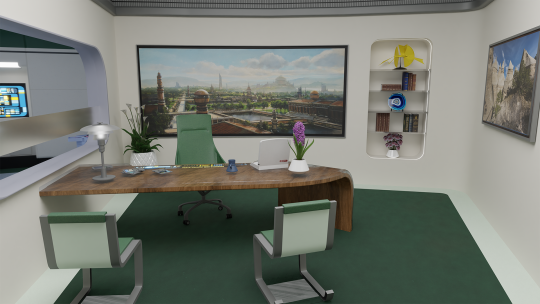

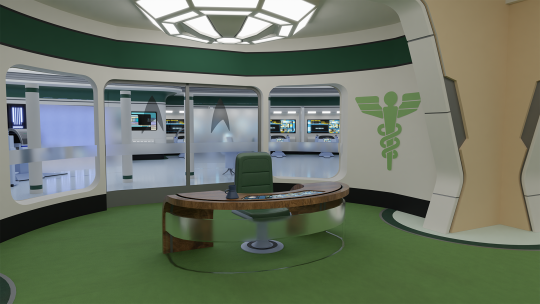


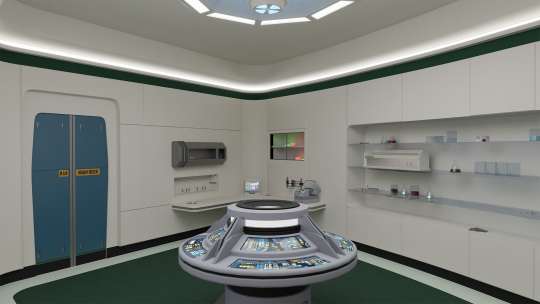
The breakdown for these areas is below the cut.
The first thing, as always, is a block-out and scale test for the environment. This was based on a very detailed document I was given to give me some art direction.


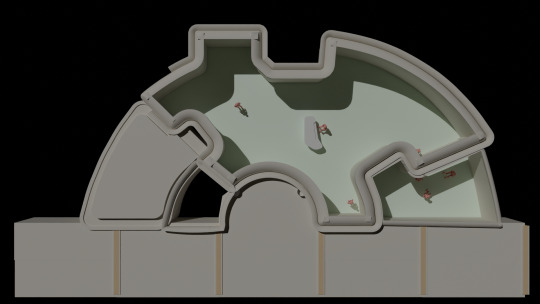
Much like previous modelling I've done, I planned to do this as a single modelled area, but eventually pivoted to modelling each room individually. This gave me a lot more flexibility to alter things in the rooms but not messing up the whole scene. It did introduce some other issues, but I can live with the trade-offs.
The next thing to work out was the hallways.
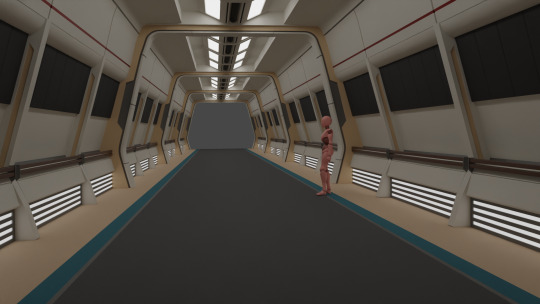

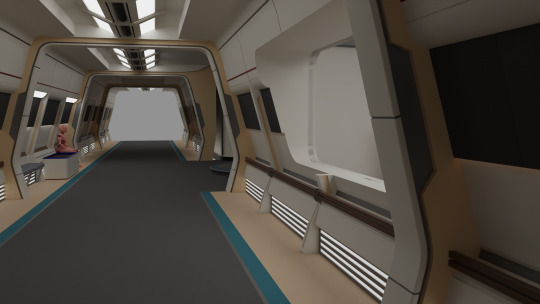
These are based on the Star Trek Online aesthetic, and I decided while I was modelling individual sections that it would be much easier to have a modular system that I can twist around corners, or switch out parts for doors, consoles, windows, or whatever else was needed.
It also allowed me to (shameless plug incoming) put together my Star Trek horror/backrooms video Deck Zero. Give it a run, if you're into that sort of thing!
Once I was happy that I could create corridors to order, I started on the lab.
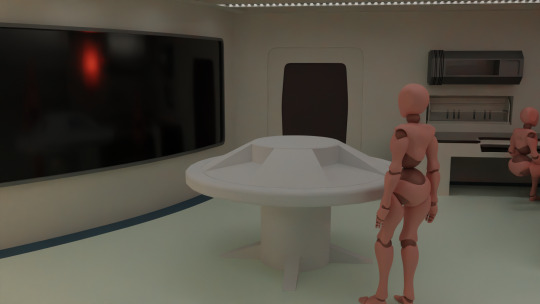


This is when I started working on the individual room modelling, which was a bit of a process to get right. Basically I modelled a single section of the room, then made it form along a curve in the shape of the room. This allowed me a lot more freedom to alter the room out, although came with a lot of teething problems initially, but came out looking better in the end, I think.
The elements in the room which I needed to ensure were present, included the circular computer console, the side desk, the TNG-era....wall orb...the corner desk, and the shelving. So obviously the next step was to do those.

After that, I had worked with the new method to build the room enough to be comfortable with it, so I started on the main sick bay and attached office.
Obviously this was probably the big focal point, so a lot of variations on a theme here, but the key is/was that it have a lot of bio-beds, a transporter, and several ways in/out of the rooms.


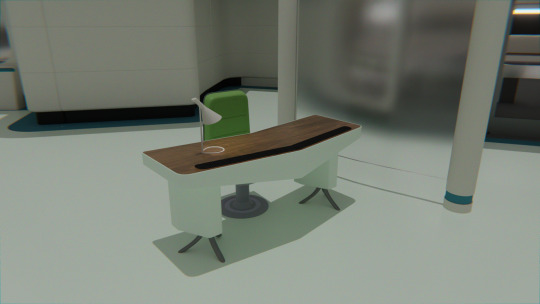



This meant building out a lot of assets, from the bio-beds, to the "laptops" used in TNG/Voyager, medical tricorders and other equipment, and the desks and trolleys to put this stuff on.

You might notice a lot of very specific tools which have been present in various Star Trek's over the years. I always like putting little touches in like this, as it helps sell the authenticity.


The CMO using the office is Bajoran, hence the painting on the rear wall. The shelves will eventually be filled out with various knicknacks including books, and a model of a Bajoran lightsail ship.

The window out into the corridor was also a request.
The last area to cover was an airlock to the internal cetacean ops to allow for medical teams to quickly access it. This was relatively easy to throw together, compared to the rest of the area.

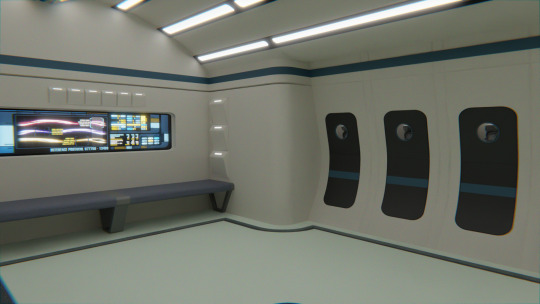
And finally, it was putting the finishing touches in, like accurate LCARS, lighting, and all the other elements that go into making the final images at the start of the post.
39 notes
·
View notes
Note
hello! i was wondering if theres any ttrpgs set in/inspired by Terry Pratchett's Discworld? thanks :)
THEME: Discworld
I love the Discworld books and I'm very glad you asked this question. I have three resources for you!



A One In A Million Chance At Adventure, by Jocher Symbolic Systems.
This is a game where you play the roles of, often unwilling, sometimes zealous, pawns in the cosmic octarine coloured narrative. Your character is not necessarily a "hero" per se, instead one could possibly see it as being important to the story. Characters like yourself do have a knack for not dying as often as a common mortal (or undead if that has been your unfortune).
With this follows that you'll naturally have a higher chance of actually, possibly, doing some heroic deeds, just by sheer mathematical logic. Unless, of course, you are the type of adventurer who'd prefer a cup of hot tea and soft slippers and a reliable day job.
That does severely reduce the odds of let's say beheading a mythical beast of ill repute or befriending the immodest wood nymphs of Howondaland*.
*if your day job happens to be for example a tax collector this is not true, this and similar careers have shown to increase the risk of leaving the disc rather early. ** only rumoured, no one who has gone looking for them has ever returned.
This is a free, fan-made d10-based game written in the style of Terry Pratchett’s Discworld novels, footnotes and all. The characters you build are expected to be flawed in some way - they have vices that can cause problems for them and plenty of skills (or spells) to help them get out of trouble.
A One in A Million Chance At Adventure has plenty of supplements to support the game, including an introductory adventure: The Murder of Dominick Kolchak, and a character supplement: The A-M Professions Character Build Guides.
Discworld Roleplaying Game, by Steve Jackson Games.
There's a lot of unusual stuff on the Disc, but don't worry about getting lost – game author Phil Masters has crafted a roadmap to Pratchett-inspired storytelling.
Visit settings like the most dubious city in the multiverse, Ankh-Morpork. Intervene in the cultural interactions of trolls and dwarves (but watch out for flying axes). Campaign for goblin rights. Flee from an angry Swamp Dragon (two feet of mindless fury and high-explosive digestion). Even find out why the second-greatest lover on the Disc needs a stepladder.
And remember, the world is round. And also flat.
This is the official roleplaying game published by Steve Jackson Games, the creators of Munchkin and GURPS - which means that this game also uses the GURPS system. Characters are pretty in-depth and require some time to put together - and that means the the core rulebook is a pretty hefty read. If you like big games with heavy modularity and a lot to chew on, maybe this game is for you!
If you want to try the game out and need a little help, there’s a GURPS Character sheet app available to help you put characters together, and Chris Normand is an avid enthusiast with many videos providing advice on how to get a grip on the system.
The Kleptomancer’s Crypt, by Max Kāmmerer.
The Kleptomancer’s Crypt is an adventure for Troika!, but is easily adapted to other systems. It mostly consists of tables to help you generate a variable adventure. Improvisation and interpretation by the GM required.
A client hired you to break into the Kleptomancer’s Crypt and so you did. Now you need to get out of the place. The Kleptomancer is a government official tasked with redistributing the wealth by stealing from the rich and keeping what they stole for themselves. Okay, that last part isn’t in the official job description. The Crypt is filled with all kinds of strange things and rooms and people, really. You might for example encounter pipe smoking sloths, boardgame playing plants, ever expanding spheres or the Kleptomancer’s apprentice. The place is dangerous, so you prepared by cutting a deal with death, preventing you from dying while you are in the Crypt.
To be clear, this is not a full game. It is simply an adventure for one.
The eclectic tone of Troika fits Discworld so well that I’m not at all surprised that there is an adventure made for it. If you have experience with Troika, or even with other OSR games, you might want to check this one out.
145 notes
·
View notes
Text
thinking about how kingdom hearts 358/2 days is a very bad game but a brilliant art piece. in that it is built from the ground up to make you *feel* the contextless, confusing, repetitive drudgery that was the all too short lives of roxas and xion. yeah part of it is that it was a kh side game for the DS in 2009 but like. aside from the general clunkiness and horrifically tedious and/or unbalanced missions, consider the fucking panel bullshit. a combined modular leveling, spell, and inventory system. levels are items that you earn and have to manually equip. compare and contrast this to most of the other KH games, which are more standard ARPGs with leveling being a permanent power increase for the playable character.
what does this mean for roxas (and xion)? it means that *none of their power belongs to them.* they don't own it. it isn't theirs. if you remove everything from the panels, wipe them clean, they're level 1 with no abilities again. consider how this matches perfectly with how they were unknowingly parasitizing sora and each other, how they were told they weren't real people, how they had to scrape and claw for any amount of information or explanation, how they were less than a year old with no memories yet had the bodies of teenagers. bodies that were incomplete copies of others, not that they knew that. at any moment they could be stripped bare of what little power and individuality they'd claimed, and sure enough, that's what happened!
hilariously enough i had maybe the best possible opportunity to recognize all of this, because guess what? i had just as much context as roxas and xion did when i played 358/2 days. a friend gave it to me and she often talked about the organization members, so i knew them, but i had no clue who sora or kairi or riku were. i didn't know that roxas was doomed from the start or that xion was *even more* doomed due to not existing at all in kh2. i didn't have a fucking clue that i was watching a tragedy play out until suddenly these children were forced to fight to the death and the victor was beaten unconscious and kidnapped and then the credits rolled. and i didn't need that context to care about them, just as they didn't need that context to care about each other!
it is impossible to accurately remake 358/2 days. making it a *good* game would betray its themes. replacing it with a slideshow and cutscene movie removes all the empty space and frustration, but also all the small charming moments and artistic flourishes (consider "roxas, that's a stick" and xion's constantly shifting appearance) that made it so compelling in the first place. truly the best worst game of all time
#also if it was remade they would probably tone down how transgender xion is#which. is so very unacceptable#kingdom hearts
15 notes
·
View notes
Text
HELLFORGED
I recently put out the HELLFORGED SRD, the system behind HELLGUTS and HELLDROPPERS, and three games made with it! I’ll be talking about all of that in this post.
First off, the HELLFORGED Jam is live now! Come join it and make a HELLFORGED game or content for an existing HELLFORGED game!
Now for the system itself. HELLFORGED games are geared for providing badass, over-the-top results for rolls as multiple successes stack together. It was created with combat in mind, but I would be so down to see a system made that didn’t focus on combat while still providing big, awesome moments. If you want to, you could also make a HECKFORGED or an H-FORGED game and avoid the word “hell” in your game all together.
Packaged with the HELLFORGED SRD and also available on its own is the XHell. XHell is a one-page HELLFORGED alien invasion game designed to show off the basics of HELLFORGED and give designers an easily-hackable jumping off point.
HELLMECH is a HELLFORGED mech game! It’s unique spin is that you’re playing as a black ops mech team, taking on missions throughout the galaxy that you could be disavowed for. To add to the political intrigue is a system of getting advantages from your crew, but risking something dramatic happening with a crewmate in the process, including death and betrayal. There’s a modular system for mech building and lots of options for putting together your mech weapons. I think it turned out really well!
Finally, I just put out HellTrain as part of the One-Page RPG 2024 Jam using the optional theme of “transport”. I wrote it on a Twitch stream where I showed how to reskin XHell to make a game. It turned out being a pretty rad sci-fi/gunslinging game about defending a train from bandits, hellhounds, and giant rattlesnakes. There is also a whole thing with souls being swapped between clone bodies that becomes a kind of character selection thing.
If any of that interests you, check them out! If you’re a designer or think you could try it out, I’d love to see you on the HELLFORGED Jam! The jam is open at least through the end of the year.
--Daily
#ttrpg#indie ttrpg#ttrpg design#ttrpg dev#hellguts#tabletop games#hellforged#helldroppers#indie ttrpgs#hellmech#helltrain#xhell
20 notes
·
View notes
Text
Oh, good, the weather is looking like it won't rain on either the several block walk to or from the cafe that's hosting the makerspace meetup — it'll likely be safe to take my modular synth. (Knock on wood, or some other appropriate superstitious appeasement of malign spirits.)
Here's a ModularGrid map of what it's presently got in it:

And then the case has my decorations in stencil and cut vinyl:



I haven't really shown off this iteration of my system before — I didn't complete the case before the Makerspace burned down last fall.
(Though I was recently kind of tickled that after I'd posted some of these pictures on Reddit, another user decided to also make their custom case tarot themed and include a shoulder strap. They went with The Magician, and honestly it's probably better done than mine, but it's kinda cool serving as inspiration, y'know?)
3 notes
·
View notes
Text

My GenCon bookstack!
There's a lot I can say about my first GenCon, but for now I just wanna talk about the cool games I picked up. Starting from the bottom:
Spire: the City Must Fall by Grant Howitt & Christopher Taylor
You got your oppressed elves and your ruling elves and a big ol fucked up city to skulk around in. Anyone who knows me knows I love the themes of this game. @monsterfactoryfanfic just did a fantastic video essay on the game that really highlights the politics and setting, which are what drew me to it in the first place. Grant and Chris signed this one for me, which was unexpected! I picked up Orc Borg for a friend at the same time.
Thousand Year Old Vampire by Tim Hutchings
The ultimate solo game; how could I resist? You are the titular vampire and you live lifetime after lifetime, trying and failing to hold onto memory. This book is so aesthetically pleasing! Very excited to crack it open and play.
Voidheart Symphony by Minerva McJanda
You have the real world and you have the Void, and you gotta try and rescue people from the Castle in the Void. Inspired by Persona! I'd heard of this one in name only - I kept conflating it with other games, though I couldn't tell you which ones. This one's also published by Rowan Rook & Deckard. I was intrigued by the mechanics of this one. Playbooks that change based on whether you're in the city or in the void? hell yeah, I'll give that a try. (also it was less expensive than Heart, which I was on the verge of buying)
Dream Askew/Dream Apart by Avery Alder and Benjamin Rosenbaum
Dream Askew has you playing queer post apocalyptic survivors in a community outside of what remains of society. Dream Apart is an alternate history of an Eastern European Jewish community. This is one I've been eyeing for a while. It felt like the gap in my game design knowledge - defining "belonging outside belonging" online turns into a cyclical discussion, so straight to the source I went.
CBR+PNK by Emanoel Melo
Technically my partner picked this one up, but I was an enabler for it. Love cyberpunk. Do not love six pages of rules for a machine gun (looking at you, Shadowrun). The design of this one is super tight, both in terms of game design and in its packaging/materials design. It comes with dry erasable character pamphlets!
Bang: The Duel by Emiliano Sciarra
Okay so it's a board game, not a book. my bad. I love the original game and my partner and I like playing two player games, so this was a fun find.
Void 1680 AM by Ken Lowery
I can't gush about this game enough. You play a lonely radio DJ taking calls from your listeners. It's a solo game where you build a playlist and it takes me back to my radio days! I was so excited to see this at the @indiepressrevolution booth at the con!
Hunt by Spencer Campbell
This one was also new to me, but I knew I'd buy something at the GilaRPGs booth. I was sold on it as Lumen 2.0, because I already adore the Lumen system. You play a doomed order of knights on a quest to slay a beast. If you succeed, the order is saved, and if not, it's doomed. The design of this one is really tight and modular, so even though it's a self-enclosed one-shot, you could certainly run it repeatedly with different combos every time.
I almost bought so many games, but I did have to be mindful of my spending! Honorable mentions I'll hopefully get in the future: Monster of the Week, Thirsty Sword Lesbians, Into the Wyrd and Wild, Anamnesis, Slayers, Moonlight on Roseville Beach, Cowboys with Big Hearts, Signal to Noise, I Have the High Ground, Apocalypse Keys, and more I'm sure I'm forgetting!
It was absolutely wild to see so many games I've got in PDF in print, and to meet a few designers and publishers I admire!
#the lady rambles#gencon 2023#perhaps someday i'll shake the feeling of being completely out of my depth
27 notes
·
View notes
Text
Recent Activities of Transparent Tribe (APT36)

Transparent Tribe, also known as APT36, is a Pakistan-based threat group active since at least 2013. They have consistently targeted Indian government, defence, and aerospace sectors. Recent activities indicate a significant evolution in their tactics and tools.
May 2024: Targeting Indian Defence and Aerospace Sectors

In May 2024, Transparent Tribe intensified cyber-espionage operations against India's defence and aerospace sectors. They employed phishing emails containing malicious attachments or links to deploy various tools, including:
Crimson RAT: A remote access Trojan used for data theft and surveillance.
Poseidon: A Golang-based agent compatible with Linux and macOS systems.
Python-based downloaders: Compiled into ELF binaries to target Linux environments.
The group also exploited India's development of indigenous Linux-based operating systems, such as MayaOS, by distributing Executable and Linkable Format (ELF) binaries to compromise these systems. [Source]
Late 2023 to Early 2024: Evolution of ElizaRAT Malware
Between late 2023 and early 2024, Transparent Tribe advanced their malware capabilities by developing ElizaRAT, a Windows Remote Access Tool. ElizaRAT's evolution included:
Enhanced Evasion Techniques: Improved methods to avoid detection by security systems.
Cloud-Based Command and Control (C2): Utilisation of services like Google Drive, Telegram, and Slack for C2 communications.
Modular Payloads: Deployment of additional payloads such as ApoloStealer for targeted data exfiltration.
These developments indicate a strategic shift towards more sophisticated and flexible attack methodologies. [Source]
September 2023: Infrastructure Expansion and Linux Targeting
In September 2023, investigations revealed that Transparent Tribe expanded their infrastructure, employing Mythic C2 servers hosted on platforms like DigitalOcean. They also began targeting Linux environments by distributing malicious desktop entry files disguised as PDFs. This approach aimed to compromise systems running Linux-based operating systems, aligning with India's adoption of such systems in government sectors. [Source]
June 2023: Focus on Indian Education Sector
By June 2023, Transparent Tribe shifted focus to India's education sector, distributing education-themed malicious documents via phishing emails. These campaigns aimed to deploy Crimson RAT, enabling the group to exfiltrate sensitive information from educational institutions. [Source]
These recent activities demonstrate Transparent Tribe's persistent efforts to adapt and refine their tactics, expanding their target spectrum and enhancing their malware arsenal to effectively compromise systems across various sectors.
Author: Kelly Hector
Blog: Digitalworldvision
2 notes
·
View notes
Text
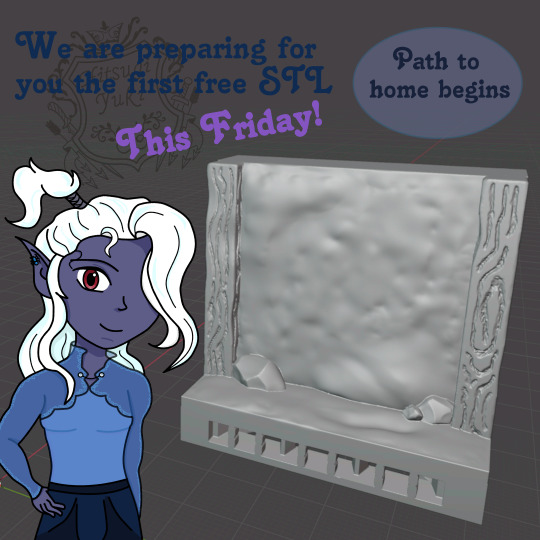
On Friday, you can expect the first free STL for a modular dungeon themed around mines.
At the same time, I decided to use the opelock system so that you can use the endless possibilities of dungeons across the world and the artist of various dungeons.
Good evening, morning and day everyone 😊
Your architect of underdark
#dnd#ttrpg#3d model#rpg terrain#tabletop terrain#wargaming terrain#dnd terrain#dungeons and dragons#game master#dnd community
3 notes
·
View notes
Text
Gameplay Diary 3/11/2024
Hello, short post this week as things were mostly the same as the last session. A lot of roleplay and trying to learn about NPCs. The main topic I want to focus on is actually my friend's game, which we played right after mine. To give background, the other players and I were sent to find out what was making the population of a dungeon act aggressive towards the inhabitants of the village. The first issue that we came across was the fact that we were told that our reward for the quest was based on how many creatures in the dungeon we left alive. The second was the fact that we were on a time limit without information on how long we would need to spend in this mine. The third was that the NPC who gave us the quest had no other information or leads to give us outright. This leads to a group of four adventurers going into a dungeon with a strong “Do not kill” protocol in mind which then leads to all of us running through the dungeon to find the source of the issue as fast as possible. Not ideal if you worked on the dungeon as he did but the optimal strategy for a group who has such limited knowledge. Now the blame can easily be placed on us as players. We didn’t search out any information but, to us, this dungeon could have been large and demanded every second of our time. The problem with a GM blaming players is that it never works. As a GM you should expect players to show up, play your game, and do nothing else. The people you play with are smart, cunning, and good problem solvers. Players, with a capital P, are flighty, quick to act on limited knowledge, and prone to running into more problems than they can solve. All of this made me consider the idea of how GMs make dungeons. There is a large amount of information on how to make an interesting dungeon. The five room rule being one that many people look to along with the ideas of different elevations, a theme that spans through the puzzles, fights, and lore, and ways to guide players through a dungeon so they see everything you want them to. I would like to take all of this game design knowledge and transform it into a way for Providence’s to follow a few steps or guides that will lead them to making an adventure, dungeon included, that helps the Providence know how much EXP each section gives, what kind of knowledge is necessary for the players to not get blindsided, what kind of knowledge is beneficial but not crucial for the players, and how to have different parts of the adventure flow into one another. This is a daunting task as the modularity of an adventure and the Providence’s ability to improv when the players go off of the plan is one of the largest draws for TTRPGS. The idea of just throwing a Providence to the wolves, saying something along the lines of “Dungeons are things in the ground and adventures are fun romps you experience with friends, you figure out the rest” irks me as the GMs, especially those who are new or don’t research level design, can fall into simple pitfalls that make an adventure not live up to what they expect. My main goal of the mechanic will be to assist in avoiding these pitfalls while also keeping the “Adventure outline” simple and easy to make so that a Providence can make up additional sections or entire adventures using the system without too much strain and without ruining the flow of the game. If anyone has any advice with things that are similar to this or have any questions, feel free to send an ask or a message!
7 notes
·
View notes
Text
Introduction
About us/the blog: We're a polyfragmented DID system that recently realized we're modular and even more recently that we're fractal. Due to our inherent isolation from the plural community(especially from other dissociative systems) and the lack of resources and written accounts from other modular systems, we're starting this blog. Sharing our story and experiences is also part of us trying to heal so cvnt on thattt too
We're in DID therapy. Our brain has audhd and PNES amongst other things, and those play major roles in how our modularity works and presents.
Our system has no individual alters nor fragments, however we've named different clusters and patterns. Plural they/them is preferred when referring to us, but when referring specifically to the host cluster, we use she/her and the name Basil.
Bodily we're a transgirl, adult, and from an eastern european country. We don't expect to vent about our trauma history, but also let's be real, one isn't the most likely to be like us if OEA wasn't involved, at least imo..
Terminology we use: To aid us in understanding and communicating our experiences, we've coined several terms that we'll use throughout this blog: Particle - that's what we call the smallest 'base' dissociative parts of the system. They have no sense of self, hold only one very particular trait/memory/sensation/etc, and feel unique to our modularity rather than like fragments non-modular systems might experience Flare - when multiple(usually dozens) of particles come together and merge, the result is a flare. It's a temporary type of system member that exists to fulfill a particular purpose or because of a trigger. once their work is done (may take milliseconds may take hours, rarely more than a day), they get disassembled back to particles. There's a flare fronting(and probably constantly switching) at all times. Once a flare is disassembled, it's near impossible to see them again, although a similar flare might come to existence at some point. Nebula - this is the clustering and grouping of particles. These clusters have an overarching theme (such as shared trauma, shared general purpose, etc) and the flares that come out of them often have many similarities. Basil, for example, is the 'host nebula'. These clusters have formed naturally and, due to how messy having so many particles and complexity is, they tend to be big and nebulous. Hence the name, heh
For more info and more terms we've coined, we have a list here: https://pluralpedia.org/w/User:RedactedSys
DNI: We don't have a dni criteria, but we'd like to keep syscourse and similar away from this blog as the point is to journal about our modularity, not get into discourse
#modular#modular did#fractal did#fractaline did#DID#did system#actually did#complex dissociative disorder#CDD#cdd system#polyfragmented#polyfrag did#fractal system
5 notes
·
View notes
Text
Unlock Global Opportunities with Zoqq: The Future of Virtual Banking

In today's globalized world, businesses need more than just traditional banking solutions. They need a financial platform that is flexible, efficient, and designed to scale with their growth. That’s where Zoqq comes in. With Zoqq, you can simplify international transactions, streamline expense management, and customize your banking experience—all while saving on fees. Here’s how Zoqq can transform your business.
1. Expand Your Reach with Global Banking
Breaking into international markets can be challenging, but managing your finances doesn’t have to be. Zoqq’s multi-currency account allows you to receive payments from over 190 countries, giving your business a truly global reach. Whether you're an e-commerce store, a freelancer, or a growing enterprise, Zoqq offers:
Low currency conversion fees to save you money on international transactions.
Fast, efficient payment processing, ensuring you get paid without delay.
A seamless way to handle cross-border transactions, all from one account.
With Zoqq, expanding your business globally has never been easier.
2. Simplified Expense Management
Managing business expenses can quickly become overwhelming, especially if your team is spread across different locations. Zoqq makes this process easier by offering a comprehensive expense management system. With Zoqq, you can:
Create and send invoices in just a few clicks.
Pay bills directly from your account, reducing administrative hassle.
Track your spending in real-time using Zoqq’s integrated corporate card, ensuring that you stay on top of your finances without the need for external tools.
Zoqq puts you in control of your expenses, so you can focus on growing your business, not managing receipts.
3. Customize Your Banking Platform with Zoqq’s Modular Option
No two businesses are the same, and your financial platform should reflect that. With Zoqq’s Modular Custom-Built Option, you can build a banking experience that’s as unique as your brand. Without any coding knowledge required, you can:
Brand the platform with your logo and custom domain.
Choose from a variety of themes powered by AI, ensuring that your banking portal looks professional and aligns with your brand identity.
Customize the dashboard to suit your specific business needs, making it easier to access the tools and features you use most.
This adaptability means that Zoqq can grow with your business and scale as your financial needs evolve.
4. Quick and Easy Self-Service
Nobody wants a lengthy onboarding process when switching financial platforms. With Zoqq, getting started is a breeze. Our self-service approach allows you to sign up and get your account running in no time, thanks to our automated onboarding system. You’ll be up and running faster than ever, with minimal effort required on your part.
At Zoqq, we believe that your time is valuable, and we’ve designed our platform to let you focus on your business while we handle the details.
The Future of Banking is Here
Zoqq is more than just a virtual bank—it’s a platform built for modern businesses looking to operate on a global scale. From effortless global transactions to a fully customizable experience, Zoqq offers everything you need to manage your business finances efficiently and effectively.
Ready to take your business to the next level? Sign up with Zoqq today and experience a new era of virtual banking.
3 notes
·
View notes
Text

Comparing Laravel And WordPress: Which Platform Reigns Supreme For Your Projects? - Sohojware
Choosing the right platform for your web project can be a daunting task. Two popular options, Laravel and WordPress, cater to distinct needs and offer unique advantages. This in-depth comparison by Sohojware, a leading web development company, will help you decipher which platform reigns supreme for your specific project requirements.
Understanding Laravel
Laravel is a powerful, open-source PHP web framework designed for the rapid development of complex web applications. It enforces a clean and modular architecture, promoting code reusability and maintainability. Laravel offers a rich ecosystem of pre-built functionalities and tools, enabling developers to streamline the development process.
Here's what makes Laravel stand out:
MVC Architecture: Laravel adheres to the Model-View-Controller (MVC) architectural pattern, fostering a well-organized and scalable project structure.
Object-Oriented Programming: By leveraging object-oriented programming (OOP) principles, Laravel promotes code clarity and maintainability.
Built-in Features: Laravel boasts a plethora of built-in features like authentication, authorization, caching, routing, and more, expediting the development process.
Artisan CLI: Artisan, Laravel's powerful command-line interface (CLI), streamlines repetitive tasks like code generation, database migrations, and unit testing.
Security: Laravel prioritizes security by incorporating features like CSRF protection and secure password hashing, safeguarding your web applications.
However, Laravel's complexity might pose a challenge for beginners due to its steeper learning curve compared to WordPress.
Understanding WordPress
WordPress is a free and open-source content management system (CMS) dominating the web. It empowers users with a user-friendly interface and a vast library of plugins and themes, making it ideal for creating websites and blogs without extensive coding knowledge.
Here's why WordPress is a popular choice:
Ease of Use: WordPress boasts an intuitive interface, allowing users to create and manage content effortlessly, even with minimal technical expertise.
Flexibility: A vast repository of themes and plugins extends WordPress's functionality, enabling customization to suit diverse website needs.
SEO Friendliness: WordPress is inherently SEO-friendly, incorporating features that enhance your website's ranking.
Large Community: WordPress enjoys a massive and active community, providing abundant resources, tutorials, and support.
While user-friendly, WordPress might struggle to handle complex functionalities or highly customized web applications.
Choosing Between Laravel and WordPress
The optimal platform hinges on your project's specific requirements. Here's a breakdown to guide your decision:
Laravel is Ideal For:
Complex web applications require a high degree of customization.
Projects demanding powerful security features.
Applications with a large user base or intricate data structures.
Websites require a high level of performance and scalability.
WordPress is Ideal For:
Simple websites and blogs.
Projects with a primary focus on content management.
E-commerce stores with basic product management needs (using WooCommerce plugin).
Websites requiring frequent content updates by non-technical users.
Sohojware, a well-versed web development company in the USA, can assist you in making an informed decision. Our team of Laravel and WordPress experts will assess your project's needs and recommend the most suitable platform to ensure your web project's success.
In conclusion, both Laravel and WordPress are powerful platforms, each catering to distinct project needs. By understanding their strengths and limitations, you can make an informed decision that empowers your web project's success. Sohojware, a leading web development company in the USA, possesses the expertise to guide you through the selection process and deliver exceptional results, regardless of the platform you choose. Let's leverage our experience to bring your web vision to life.
FAQs about Laravel and WordPress Development by Sohojware
1. Which platform is more cost-effective, Laravel or WordPress?
While WordPress itself is free, ongoing maintenance and customization might require development expertise. Laravel projects typically involve developer costs, but these can be offset by the long-term benefits of a custom-built, scalable application. Sohojware can provide cost-effective solutions for both Laravel and WordPress development.
2. Does Sohojware offer support after project completion?
Sohojware offers comprehensive post-development support for both Laravel and WordPress projects. Our maintenance and support plans ensure your website's continued functionality, security, and performance.
3. Can I migrate my existing website from one platform to another?
Website migration is feasible, but the complexity depends on the website's size and architecture. Sohojware's experienced developers can assess the migration feasibility and execute the process seamlessly.
4. How can Sohojware help me with Laravel or WordPress development?
Sohojware offers a comprehensive range of Laravel and WordPress development services, encompassing custom development, theme and plugin creation, integration with third-party applications, and ongoing maintenance.
5. Where can I find more information about Sohojware's Laravel and WordPress development services?
You can find more information about Sohojware's Laravel and WordPress development services by visiting our website at https://sohojware.com/ or contacting our sales team directly. We'd happily discuss your project requirements and recommend the most suitable platform to achieve your goals.
3 notes
·
View notes
Text
How Will Interior Design Evolve in the Future?
Interior design is a dynamic field that continually adapts to new trends, technologies, and cultural shifts. As we look ahead, the future of interior design promises to be even more innovative and responsive to the needs of a changing world. In this article, we'll explore the trends and technologies that are set to shape the interiors of tomorrow.
1. Embracing Sustainable Design
One of the most significant shifts in interior design is the growing emphasis on sustainability. As concerns about climate change and resource depletion intensify, designers are prioritizing eco-friendly materials and practices.
Eco-Friendly Materials: The future will see a rise in the use of sustainable materials like reclaimed wood, bamboo, and recycled metals. These materials not only reduce environmental impact but also add a unique aesthetic to spaces.
Energy Efficiency: Future interiors will incorporate energy-efficient lighting, smart thermostats, and solar panels. Homes and offices will be designed to minimize energy consumption and reduce carbon footprints.
2. Smart Homes and Integrated Technology
Smart home technology is revolutionizing how we interact with our living spaces. The future will see even more integration of smart devices, creating homes that are not only more convenient but also more efficient.
Voice-Controlled Systems: Imagine controlling your entire home with just your voice. From adjusting lighting to setting the thermostat, voice-controlled systems will make daily tasks effortless.
Automated Solutions: Future homes will feature advanced automation systems that can learn and adapt to your routines. This includes everything from automated blinds that adjust based on sunlight to refrigerators that order groceries when supplies run low.
3. Personalization and Customization
As technology advances, so does our ability to personalize our living spaces. The future of interior design will see a shift towards highly customized environments that reflect individual tastes and lifestyles.
3D Printing: 3D printing technology will allow for the creation of bespoke furniture and decor items. This means that you can have unique, one-of-a-kind pieces that perfectly fit your space and style.
Modular Furniture: Future homes will increasingly feature modular furniture that can be easily reconfigured to suit different needs and occasions. This flexibility will be especially valuable in smaller living spaces.
4. Biophilic Design
Biophilic design, which seeks to connect occupants more closely to nature, will become a central theme in future interiors. This approach not only enhances aesthetic appeal but also promotes well-being.
Natural Elements: Expect to see more use of natural materials like stone, wood, and plants. Large windows and indoor gardens will bring the outdoors inside, creating a calming and rejuvenating atmosphere.
Health Benefits: Biophilic design has been shown to reduce stress, improve mood, and boost productivity. Future interiors will leverage these benefits to create healthier living and working environments.
5. Flexible and Multi-Functional Spaces
As urbanization continues and living spaces become more compact, the need for flexible and multi-functional interiors will grow. Future designs will focus on maximizing the utility of every square foot.
Convertible Furniture: Furniture that can serve multiple purposes will be key. Think of sofas that convert into beds, desks that transform into dining tables, and walls that can be moved to create different room configurations.
Adaptable Layouts: Future homes will feature layouts that can be easily adapted to different activities. This could include movable walls or partitions that allow for seamless transitions between work, leisure, and living spaces.
6. Wellness-Centric Design
The future of interior design will place a greater emphasis on wellness. As people become more health-conscious, interiors will be designed to support physical and mental well-being.
Ergonomic Furniture: Expect to see more furniture designed with ergonomics in mind, promoting better posture and reducing strain.
Air and Water Quality: Future homes will incorporate advanced filtration systems to ensure clean air and water, contributing to overall health.
7. Minimalism with a Twist
While minimalism will continue to be a popular trend, future interior design will infuse it with more personality and warmth.
Warm Minimalism: This approach combines the clean lines and simplicity of minimalism with cozy textures and inviting colors. The result is a space that feels both serene and welcoming.
Functional Minimalism: Future minimalism will focus on functionality, ensuring that every piece of furniture and decor serves a purpose. This creates uncluttered spaces that are easy to maintain and live in.
8. Tech-Infused Spaces
As technology continues to advance, it will become even more seamlessly integrated into our living spaces.
Augmented Reality (AR): AR will allow homeowners to visualize changes to their interiors before making them. This could include trying out new paint colors, furniture arrangements, or decor items virtually.
Smart Kitchens: The kitchens of the future will be equipped with smart appliances that can help with meal planning, grocery shopping, and even cooking. This will make it easier to maintain a healthy diet and save time.
9. Cultural and Global Influences
Globalization and cultural exchange will continue to influence interior design, bringing diverse styles and ideas into homes around the world.
Ethnic Decor: Expect to see more incorporation of decor items from different cultures, adding richness and diversity to interiors.
Global Design Trends: Designers will draw inspiration from around the world, blending traditional and contemporary elements to create unique and eclectic spaces.
10. Focus on Longevity and Timelessness
In contrast to the fast fashion trend in clothing, future interior design will emphasize longevity and timelessness.
Quality Over Quantity: There will be a shift towards investing in high-quality, durable furniture and decor that can withstand the test of time.
Timeless Aesthetics: Interiors will favor classic designs and neutral color palettes that won't go out of style, ensuring that spaces remain elegant and relevant for years to come.
Conclusion
The future of interior design is exciting and full of possibilities. From sustainability and smart technology to personalization and wellness, the trends and innovations on the horizon promise to transform how we live and interact with our spaces. As we move forward, the key will be to embrace these changes while creating environments that are not only beautiful but also functional, healthy, and reflective of our personal values and lifestyles. The interiors of the future will be more than just spaces to live in—they will be spaces that enhance our lives in meaningful ways.
4 notes
·
View notes